- Home
- Captain W E Johns
Biggles Pioneer Air Fighter (51)
Biggles Pioneer Air Fighter (51) Read online
ABOUT PIONEER AIR COMBAT by Captain W. E. Johns
CAPTAIN JAMES BIGGLESWORTH is a fictitious character, yet he could have been found in any R.F.C. mess during those great days of 1917 and 1918 when air combat had become the order of the day and air duelling was a fine art. To readers who are unfamiliar with the conditions that prevailed in the sky of France during the last two years of World War I, it may seem unlikely that so many adventures could have fallen to the lot of one man. In these eventful years, every day—and I might almost say every hour—brought adventure, tragic or humorous, to the man in the air, and as we sat in our cockpits warming up our engines for the dawn 'show', no one could say what the end of the day would bring, or whether he would be alive to see it. Again, it may seem improbable that any one man could have been involved in so many hazardous undertakings, and yet survive. That may be true; sooner or later most war pilots met the inevitable fate of the flying fighter. I sometimes wonder how any of us survived, yet there were some who seemed to bear a charmed life. William Bishop, the British ace, Rene Fonck, the French ace and prince of air duellists, and, on the other side, Ernest Udet, and many others, fought hundreds of battles in the air and survived thousands of hours of deadly peril. Every day incredible deeds of heroism were performed by pilots whose names are unknown.
Nowhere are the curious whims of Lady Luck so apparent as in the air. Lothar von Richthofen, brother of the famous ace, shot down forty British machines and was killed in a simple cross-country flight. Nungesser, the French champion of forty-five air battles, was drowned, and McKeever, Canadian ace of thirty victories, was killed in a skidding motor-car. Captain Jock' McKay, of my squadron survived three years' air warfare only to be killed by àrchie' an hour before the Armistice was
signed. Lieutenant A. E. Amey, who fought his first and last fight beside me, had not even unpacked his kit! I have spun into the ground out of control yet lived to tell the tale. Gordon, of my squadron, made a good landing, but bumped on an old road that ran across the aerodrome, turned turtle, and broke his neck.
Again, should the sceptic think I have been guilty of exaggeration, I would say that exaggeration is almost impossible where air combat is concerned. The speed at which a dog-fight took place and the amazing manner in which machines appeared from nowhere, and could disappear, apparently into thin air, was so bewildering as to baffle description. It is beyond my ability to convey adequately the sensation of being one of ten or a dozen machines, zooming, whirling, and diving among the maze of pencil-lines that marked the track of tracer bullets. One could not exaggerate the horror of seeing two machines collide head-on a few yards away, and words have yet to be coined to express that tightening of the heart-strings that coin' es of seeing one of your own side roaring down in a sheet of flame. Seldom was any attempt made by spectators to describe these things at the time; they were best forgotten.
It is not surprising that many strange incidents occurred, incidents that were never written down on combat reports, but were whispered in dim corners of the hangers while we were waiting for the order to start up, for the 'late birds' to come home to roost. It was
'H', a tall South African S.E. pilot, who came in white-faced and told me he had just shot down a Camel by mistake. It was the Camel pilot's fault. He playfully zoomed over the S.E., apparently out of sheer lightheartedness. 'H' told me that he started shooting when he saw the shadow; he turned and saw the red, white and blue circles, but it was too late. He had already gripped the Bowden control and fired a burst of not more than five rounds. He had fired hundreds of rounds at enemy aircraft without hitting one, but the Camel fell in flames. He asked me if he should report it, and I, rightly or wrongly, said no, for nothing could bring the Camel back. 'H' went West soon afterwards. Almost everybody has heard the story told by Boelike, the
German ace, of how he once found a British machine with a dead crew flying a ghostly course amid the clouds. On another occasion he shot down an F.E., which, spinning viciously, threw its observer out behind the German lines and the pilot behind the British lines. What of the R.E.8 that landed perfectly behind our lines with the pilot and observer stiff and stark in their cockpits! The R.E.8 was not an easy machine to land at any time, as those who flew it will remember.
Rene Fonck once shot down a German machine which threw out its pilot; machine and man fell straight through a formation of Spads below without touching one of them! The German pilot was Wissemann, who had just shot down Guynemer, Fonck's friend and brother ace, but he did not know that at the time. The coincidence is worth noting. Madon, another ace, once attacked a German two-seater at point-blank range—his usual method. A bullet struck the goggles off the Boche observer and sent them whirling into the air; Madon caught them on his wires and brought them home. When Warneford shot down his Zeppelin, one of the crew jumped from the blazing airship, and after falling for a distance generally believed to be about Zoo feet, crashed through the roof of a convent and landed on a bed that had just been vacated by a nun. He lived to tell the tale. One could go on with such stories indefinitely, but these should be sufficient to show that, in the air at least, truth is stranger than fiction. Many of the adventures that are ascribed to Biggles did actually occur, and are true in their essential facts. Students of air history may identify them. In some cases the officers concerned are still alive and serving in the Royal Air Force. Finally, I hope that from a perusal of these pages a younger generation of air fighters may learn something of the tricks of the trade, of the traps and pitfalls that beset the unwary, for I fear that many of the lessons which we learned in the hard school of war are being rapidly obscured by the mists of peace-time theory. In air-fighting, one week of experience is worth a year of peace-time practice. In peace a man may make a mistake—
and live. He may not even know of his mistake. If he makes that same mistake in war—he dies, unless it is his lucky day, in which case the error is so vividly brought to his notice that he is never guilty of it again. No one can say just how he will react when, for the first time, he hears the slash of bullets ripping through his machine. The sound has turned boys into grey-faced men, and even hardened campaigners who learnt their business on the ground have felt their lips turn dry.
In the following pages certain expressions occur from time to time in connection with the tactics of air combat which may seem to the layman to be out of proportion to their importance. For instance, he will read of 'getting into the sun'. It is quite impossible for anybody who does not fly to realise what this means and how utterly impossible it is to see what is going on in that direction, particularly when the sun is low and one is flying west. To fly into the face of the setting sun can be uncomfortable at any time, but the strain of trying to peer into the glare, knowing that it may discharge a squadron of enemy aircraft at any moment, becomes torture after a time.
It should also be remembered that an aeroplane is an extremely small vehicle and difficult to see. When one is on the ground it is the noise of the engine that almost invariably first attracts attention, and but for the unmistakeable telltale hum, few would be seen at all. In the air, the roar of one's own engine drowns all other sound, and one is therefore dependent upon sight alone for detecting the presence of other aircraft. This fact should be borne in mind when reading stories of the air, and particularly of air combat.
Constant reference is also made to àrchie'. Most people know by now that this was not an old friend whom we called by his Christian name. There was nothing friendly about archie. On the contrary, it often bit you when you were least expecting it, but on the whole its bark was worse than its bite. Archie was the war-pilot's nickname for antiaircraft gun-fire. During the war, archie batteries
stretched from the North Sea to the Swiss frontier; its appearance in the sky was accepted as a matter of course, and dodging it was part of the daily round. After a time one became accustomed to it and ignored it unless it was very bad.
HOW BIGGLES WAS 'BORN'
THESE stories of World War I were written about a character whose exploits—little suspected by me at the time—were to continue to the present day. They were written for a magazine of which I was the editor, and apart from the entertainment of the reader, had the more serious purpose of presenting a picture of war flying as it was in its infancy. It seems unlikely that anyone could have suspected the developments that were to follow and astonish us in World War II.
In the 1914 war, flying began with pilots trying to drop stones on each other. The pistol followed, then the carbine, and the first casualties occurred. The next step was an ordinary ground machine-gun. Later, this was fixed to the machine. A great stride was made when a timing gear was produced to allow first one, then two, machine-guns to fire forward through the airscrew—at that time incorrectly called a propeller. Even in 1918
armament was still primitive compared with the types that fought in the Battle of Britain. Air combat was mostly a matter of 'catch as catch can', with every man for himself. Tricks and ruses were common. Discipline was casual, for the senior officers of the R.F. C. had not had time to grow old.
In short, it was the era of experiment, of trial and error. But it was from the apparently irresponsible behaviour of the pilots of the Kaiser's war that the traditions of the air service emerged. Discipline, speed and striking power may have been stepped up, • but the human factor is the same.
GLOSSARY OF TERMS
Altimeter: The instrument used for determining the height of an aeroplane. It is not unlike a barometer, and is set in the instrument board.
Ammonal: A very powerful explosive. It was used in Mills bombs. Archie: The old Royal Flying Corps expression for anti-aircraft gun-fire. In World War II it became 'flak'
.
`Blipping': The art of opening the throttle of a rotary engine in short, sharp bursts to keep it 'alive'.
Bomb-Toggle: The bomb release handle.
Bowden Lever: The machine-guns of certain aeroplanes were fired by depressing a lever on the joystick. Sometimes a thumb button was used in the top of the joystick. Other methods were also employed according to the type of machine. Brass-Hats: A common expression meaning staff officers, no doubt originating from the gold device on the peaks of their caps—often referred to as 'bananas'. Bristol Fighter: A famous type of two-seater British all-purpose aeroplane. Buckingham: A type of incendiary bullet, calculated to set fire to anything it hit. They were used chiefly against lighter-than-air craft in order to set fire to the hydrogen gas with which these were inflated.
Camouflage: A word coined from the French, meaning 'to conceal', 'disguise', or make a thing look like something it was not. Many different forms of camouflage were employed during the war. Imitation grass mats, spread above guns, was known as camouflage. The paintings of buildings, hangars and guns in sections of different colours, in order to break up their outlines, was also known as camouflage. Centre Section: That part of the top plane of an aeroplane which comes immediately over the fuselage, and to which the wings themselves are joined. Circus: Formations of enemy aeroplanes were commonly called circuses; often they were known by the name of the leader: thus `Richthofen's circus'. Cooper Bombs: Special bombs generally reckoned to weigh twenty pounds, although as a matter of fact they usually weighed about twenty-five pounds; often carried by singleseat fighters under the wings, four each side. Deflection: The allowance made when shooting at a moving target. Briefly, it means shooting at the place where the target is expected to be when the missile reaches. it. Double-Frontiers: In order to prevent prisoners of war from escaping, the Germans, in many places, arranged artificial or false frontiers in order to lead escaping officers to believe that they had entered another country, whereas in fact they had not. Fanning (
Down) : An R.F.C. expression for blowing up with bombs. Things were fanned down, not blown up.
Flaming Onions: Missiles used by the Germans against aeroplanes in World War I. The weapons that fired them remained a mystery until the end of the war. They appeared in a series of glowing balls of fire that rose vertically from the ground. Flying Wire: Broadly speaking, the wings of biplanes were braced with two sorts of wires, flying wires and landing wires. Flying wires hold the wings in position in the air; landing wires take the weight of the wings when the machine is standing on the ground. Hannoverana: An efficient type of German two-seater, 1917-18. Inclinometer: An instrument very much like a spirit-level, set across the instrument board, the position of the bubble showing if the machine is flying level, or banking. M.O.: Medical Officer.
Nines' : De Havilland 9s, famous 2-seater bombers, 1917-18. Parachute Flares: Bright lights which had a parachute attachment in order that they should sink slowly to the ground. They were used by aeroplanes to illuminate the ground below them while nightflying. Pour Vous: Words supposed to resemble the noise made by the German Mercedes aero engine.
Rocking Wings: The signal usually employed (before the days of radio) by the leader of a formation to indicate that enemy aircraft were in sight or that he was going to attack. Rumpler: A German two-seater aeroplane used in large quantities during the war.
`Sausage': Kite balloons were sometimes called 'sausages'. German balloons were sometimes referred to as Drachens. `Shoot' (Artillery): A machine spotting for the artillery was said to be doing a 'shoot'.
Sidcot (suit): A thick, padded overall garment worn by pilots. Smudge Fire: A small fire usually kept alight on aerodromes to show landing machines the direction of the wind. Spandaus: Many German machine-guns and bullets were made at Spandau, Germany. For this reason German machine-guns were often referred to as Spandaus. Tarmac: The paved area in front of the hangars.
Triplane: An aeroplane having three wings is a triplane. During the war it usually meant the Fokker triplane; also called `Tripehound'. Sopwith triplanes were used by the British. Very Pistol: A short, large-bore pistol used for firing signal lights. CAPTAIN BIGGLESWORTH, of Squadron No. 266, R.F.C., sat shivering in the tiny cockpit of his Camel at rather less than 1,000 feet above the allied reserve trenches. It was a bitterly cold afternoon; the icy edge of the February wind whipped round his face and pierced the thick padding of his Sidcot suit as he tried to snuggle lower in his 'office'. The little salient on his right was being slowly pinched out by a detachment of infantry; to Biggles it seemed immaterial whether the line was straightened out or not; a few hundred yards one way or the other was neither here nor there, he opined. He was to change his mind before the day was out. Looking down, he could see the infantry struggling through the mud from shell-hole to shell-hole, as inch by inch they drove the enemy back.
Squadron orders for the day had been to help them in every possible way by strafing back areas with machine-gun fire and 20-lb. Cooper bombs to prevent the enemy from bringing up reinforcements. He had been at it all morning, and as he climbed into his cockpit for the afternoon 'show', he anticipated another miserable two hours watching mud-coated men and lumbering tanks crossing no-man's-land, as he dodged to and fro through a venomous fire from small-arms, field-guns and archie batteries. He was flying a zig-zag course behind the British lines, keeping a watchful eye open for the movements of enemy troops, although the smoke of the barrage, laid down to protect the advancing troops, made the ground difficult to see. It also served to some extent to conceal him from the enemy gunners. From time to time he darted across the line of smoke and raked the German front line with bullets from his twin Vickers guns. It was a highly dangerous, and, to Biggles, an unprofitable pursuit; he derived no sense of victory from the performance, and the
increasing number of holes in his wings annoyed him intensely. Ì'll have one of those holes in me in a minute,' he grumbled.
Crash! Something had hit the machine
and splashed against his face, smothering his goggles with a sticky substance.
`What's happened now?' he muttered, snatching off the goggles. His first thought was that an oil lead had been cut by a piece of shell, and he instinctively throttled back and headed the Camel nose down, farther behind his own lines.
He wiped his hand across his face and gave a cry of dismay as it came away covered in blood. 'My gosh! I'm hit,' he thought, and looked anxiously below for a suitable landingground. He had little time in which to choose, but fortunately there were many large fields handy, and a few seconds later the machine had run to a standstill in one of them. He stood erect in the cockpit and felt himself all over, looking for the source of the gore. His eye caught a sight of a cluster of feathers stuck on the centre section bracing wires, and he sank down limply, grinning sheepishly.
`Holy mackerel,' he muttered, 'a bird! So that was it!' Closer investigation revealed more feathers and finally he found a mangled mass of blood and feathers on the floor of the cockpit. `The propeller must have caught it and ch ucked what was left of it back through the centre section into my face,' he mused. `Looks like a pigeon. Oh, well!'
He made to throw it overboard, when something caught his eye. It was a tiny tube attached to the bird's leg.
À carrier pigeon, eh?' He whistled. 'I wonder if it is one of ours or a Boche?'
He knew, of course, that carrier pigeons were used extensively by both sides, but particularly by the Allies for the purpose of conveying messages from spies within the occupied territory.
Sitting on the 'hump' of his Camel, he removed the capsule and extracted a small flimsy piece of paper. One glance at the jumbled lines of letters and numbers was sufficient to show him that the message was in code.
Ì'd better get this to Intelligence right away,' he thought, and looked up to see an officer and several Tommies regarding

 Biggles in the Underworld
Biggles in the Underworld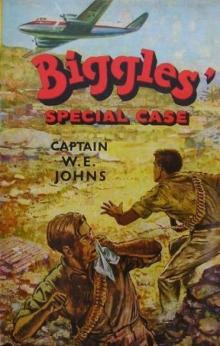 Biggles' Special Case
Biggles' Special Case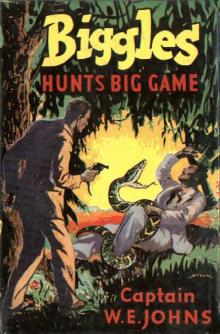 34 Biggles Hunts Big Game
34 Biggles Hunts Big Game 03 Now To The Stars
03 Now To The Stars 55 No Rest For Biggles
55 No Rest For Biggles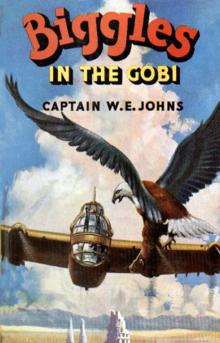 46 Biggles in the Gobi
46 Biggles in the Gobi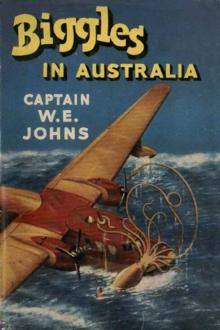 52 Biggles In Australia
52 Biggles In Australia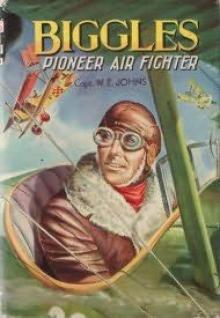 51 Biggles Pioneer Air Fighter
51 Biggles Pioneer Air Fighter 05 Biggles Flies East
05 Biggles Flies East 28 Biggles In Borneo
28 Biggles In Borneo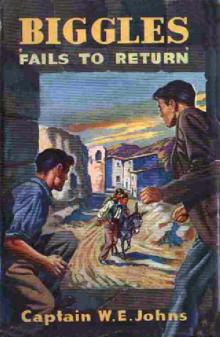 29 Biggles Fails to Return
29 Biggles Fails to Return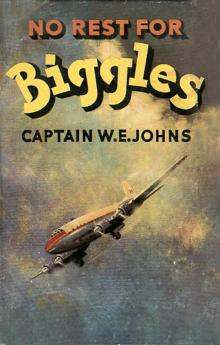 55 No Rest For Biggles (v2)
55 No Rest For Biggles (v2)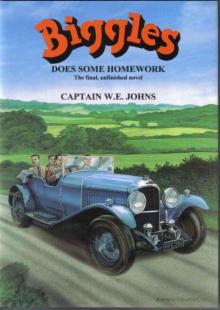 Biggles Does Some Homework
Biggles Does Some Homework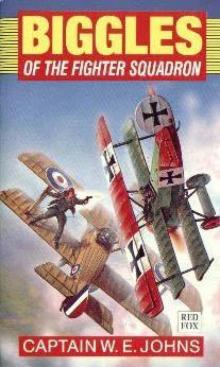 Biggles of the Camel Squadron
Biggles of the Camel Squadron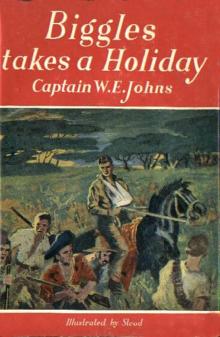 35 Biggles Takes A Holiday
35 Biggles Takes A Holiday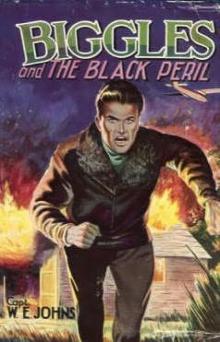 Biggles And The Black Peril (06)
Biggles And The Black Peril (06)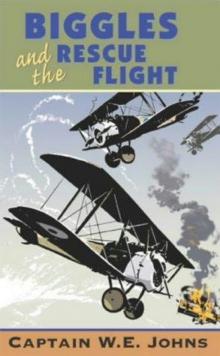 17 Biggles And The Rescue Flight
17 Biggles And The Rescue Flight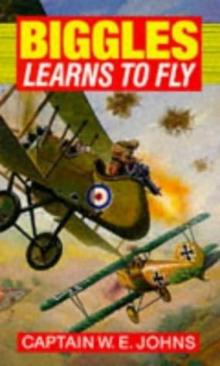 Biggles Learns To Fly
Biggles Learns To Fly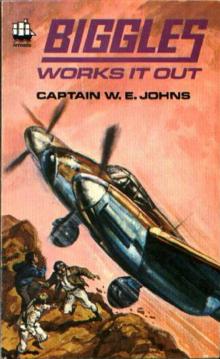 40 Biggles Works It Out
40 Biggles Works It Out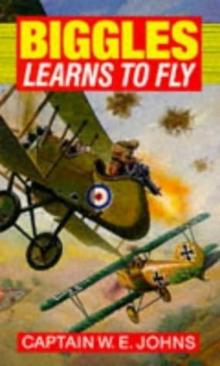 05 Biggles Learns To Fly
05 Biggles Learns To Fly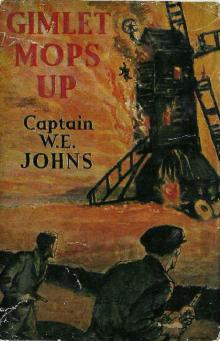 04 Gimlet Mops Up
04 Gimlet Mops Up 10 Biggles and Co
10 Biggles and Co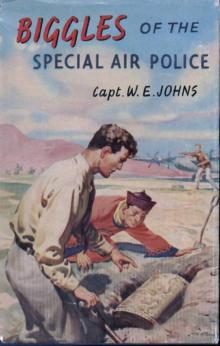 47 Biggles Of The Special Air Police
47 Biggles Of The Special Air Police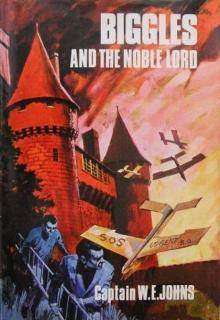 Biggles and the Noble Lord
Biggles and the Noble Lord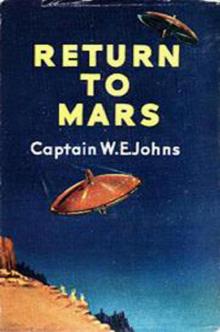 T2 Return To Mars
T2 Return To Mars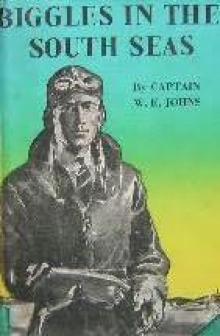 21 Biggles In the South Seas
21 Biggles In the South Seas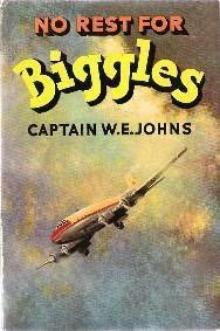 No Rest For Biggles
No Rest For Biggles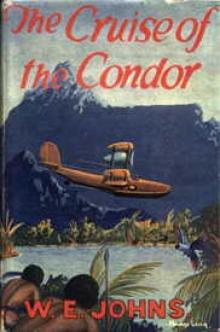 Biggles In The Cruise Of The Condor (02)
Biggles In The Cruise Of The Condor (02)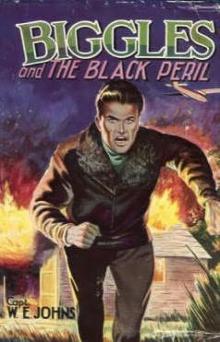 06 Biggles And The Black Peril
06 Biggles And The Black Peril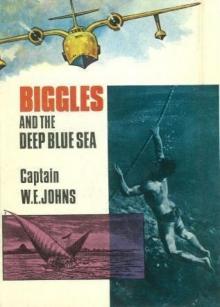 Biggles and the Deep Blue Sea
Biggles and the Deep Blue Sea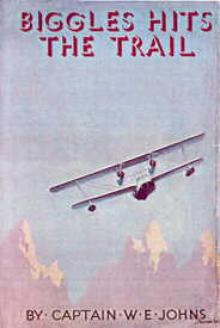 06 Biggles Hits The Trail
06 Biggles Hits The Trail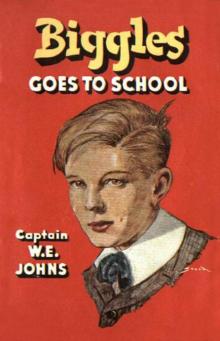 39 Biggles Goes To School
39 Biggles Goes To School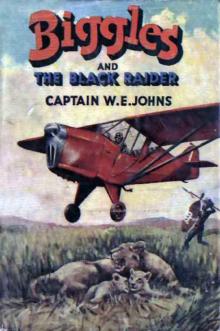 44 Biggles and the Black Raider
44 Biggles and the Black Raider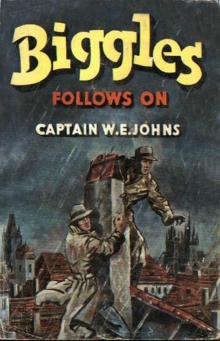 42 Biggles Follows On
42 Biggles Follows On Biggles In the South Seas
Biggles In the South Seas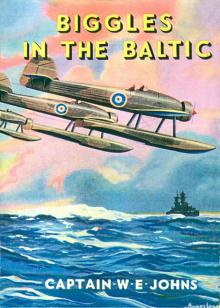 21 Biggles In The Baltic v3
21 Biggles In The Baltic v3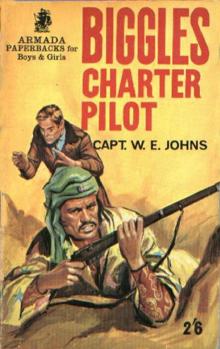 27 Biggles - Charter Pilot
27 Biggles - Charter Pilot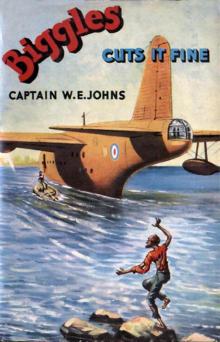 49 Biggles Cuts It Fine
49 Biggles Cuts It Fine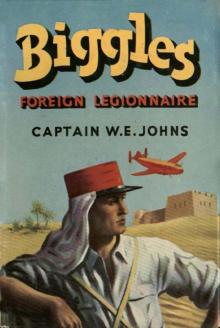 51 Biggles Foreign Legionaire
51 Biggles Foreign Legionaire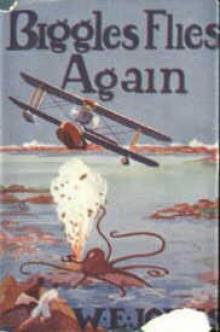 04 Biggles Flies Again
04 Biggles Flies Again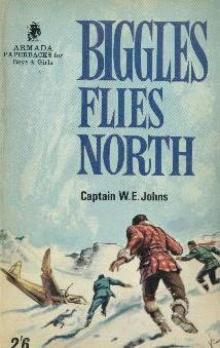 16 Biggles Flies North
16 Biggles Flies North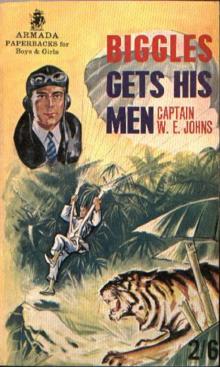 37 Biggles Gets His Men
37 Biggles Gets His Men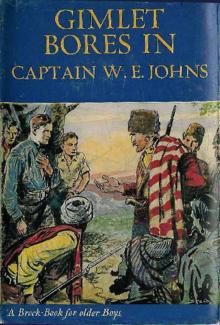 07 Gimlet Bores In
07 Gimlet Bores In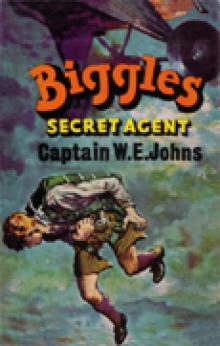 19 Biggles Secret Agent
19 Biggles Secret Agent 32 Biggles In The Orient
32 Biggles In The Orient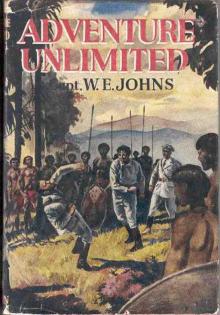 Adventure Unlimited
Adventure Unlimited 26 Biggles Sweeps The Desert
26 Biggles Sweeps The Desert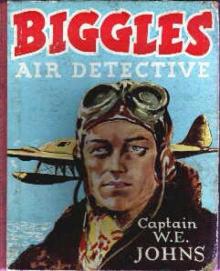 Biggles Air Detective (43)
Biggles Air Detective (43) 36 Biggles Breaks The Silence
36 Biggles Breaks The Silence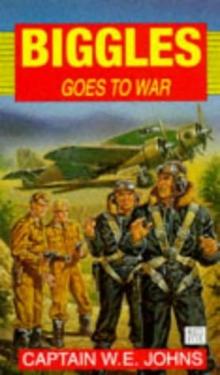 14 Biggles Goes To War
14 Biggles Goes To War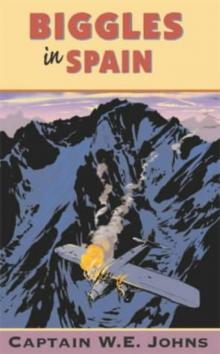 18 Biggles In Spain
18 Biggles In Spain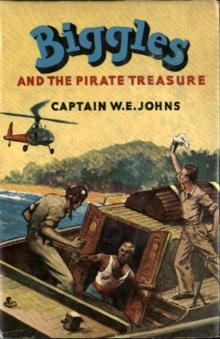 50 Biggles and the Pirate Treasure
50 Biggles and the Pirate Treasure 25 Biggles In The Jungle
25 Biggles In The Jungle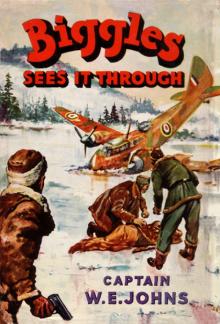 23 Biggles Sees It Through
23 Biggles Sees It Through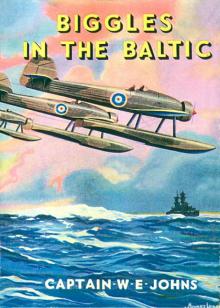 21 Biggles In The Baltic
21 Biggles In The Baltic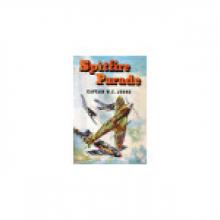 24 Spitfire Parade
24 Spitfire Parade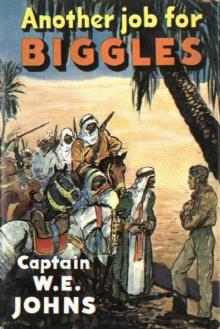 38 Another Job For Biggles
38 Another Job For Biggles 41 Biggles Takes The Case
41 Biggles Takes The Case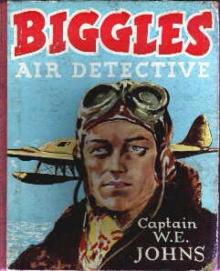 43 Biggles Air Detective
43 Biggles Air Detective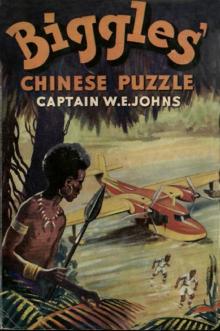 53 Biggles Chinese Puzzle
53 Biggles Chinese Puzzle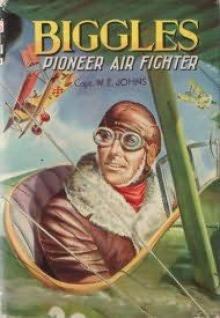 Biggles Pioneer Air Fighter (51)
Biggles Pioneer Air Fighter (51) 22 Biggles Defies The Swastika
22 Biggles Defies The Swastika 01 Kings Of Space
01 Kings Of Space